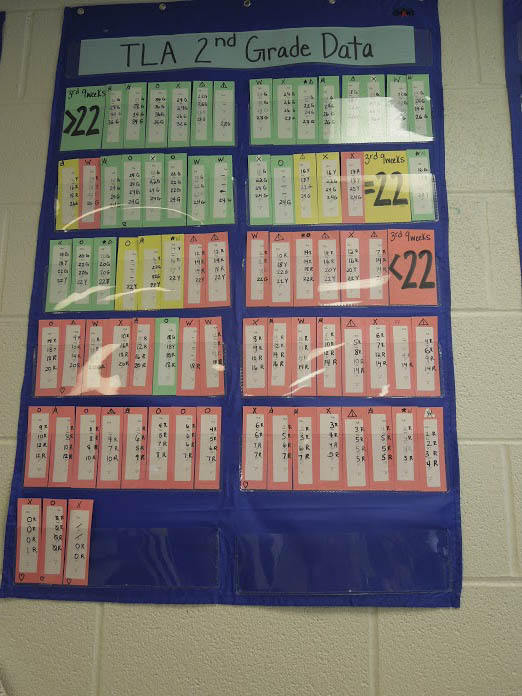Smartest kids: In Tennessee, an epic turnaround

NASHVILLE, Tenn. – Rose Park didn’t used to have much to brag about – a low-performing school in a struggling urban district in a state lurching around the bottom of national academic rankings.
Today, Rose Park Math and Science Magnet Middle School has a waiting list of more than 300 students for enrollment. Though most of its students are poor, its academic performance puts it in the top 5 percent of schools in Tennessee – a state that has shot past Michigan on some key measures of the National Assessment of Educational Progress (or NAEP) test and is now the fastest improving education state in the country.
Michigan’s scores on the NAEP, the gold standard of cross-state academic comparisons, are average or below average in every measurement.
What is happening in this nondescript building, and in thousands of other schools across Tennessee, that isn’t happening in Michigan?
Bridge visited Tennessee and three other states that are high-achieving or fast-improving to look for answers: Tennessee and Florida, where academic achievement was similar or worse than Michigan a decade ago, but where state policies have led to stunning growth; and Massachusetts and Minnesota, both acclaimed for their high-achieving students.
Tennessee’s turnaround isn’t the result of money – the state spends less per pupil than Michigan, and pays its teachers substantially less (an average of $48,049 a year, compared with $61,866). It isn’t charters - the percentage of students enrolled in charter schools is one-sixth that of Michigan.
What Tennessee does have, though, is a commitment to a set of reforms that, combined, have changed the course of its public schools. One of those policies - high-stakes teacher evaluations based partly on student test scores - is on a path to being implemented in Michigan. Other reforms, including an increased investment in teacher training and collaboration, and quick-turnaround student data, haven’t happened in Michigan.
For Tennessee, it all started with a hard look in the mirror.
Tennessee rising
Tennessee is a poorer state than Michigan. The median household income in the Volunteer State is $42,764 (44th in the nation), compared to Michigan, $46,859 (33rd); more live below the poverty line in Tennessee, and fewer have a college degree.
And, until recently, Tennessee’s children were performing worse academically.
Today, test scores tell a story of two states on different trajectories. In 2003, Michigan had NAEP scores well above Tennessee in all academic measurements. By 2013, Tennessee had raced past Michigan in 4th grade math and reading scores and was nipping at Michigan’s heels in 8th-grade measurements. Make no mistake, Tennessee remains a long way from joining the nation’s elite. Indeed, it’s scores still place Tennessee in the bottom half of states nationally. But its gains, in just a few years, are the steepest in NAEP history.
Education Trust-Midwest, an education reform advocacy group based in Michigan, estimates that, based on NAEP scores, African-American fourth-grade math students in Tennessee are now a half-year ahead of African-American students in Michigan.
Michigan was one of six states in the nation that lost ground in fourth-grade reading scores over the decade, and tied with South Carolina for the worst growth in the county in 4th grade math (Tennessee, meanwhile, tied for third best).
Jamie Woodson, president and CEO of Tennessee SCORE, an education reform group based in Nashville, tracks the turning point to 2007. That year, nine of 10 Tennessee students were judged proficient in reading on the state’s own standardized test, similar to Michigan’s MEAP. But when those same students took the National Assessment of Educational Progress, the test taken by students across the country, only three out of 10 Tennessee students were proficient.
“It was an embarrassing and public moment,” recalled Woodson, who was Republican chair of the state Senate Education Committee at the time. “It was a truth moment as a state.”
The truth was that Tennessee wasn’t very good at educating its children.
Tough love
Republicans and Democrats rallied around a series of reforms focusing on accountability for students and teachers. Tennessee became one of the first in the nation to adopt the Common Core State Standards, now in more than 40 states, a set of concepts and skills that students are expected to learn at each grade level in math and English language arts to succeed after high school. It dumped the cupcake state standardized test and replaced it with a more rigorous exam and higher “cut scores” for students to be judged proficient. Proficiency rates were cut in half overnight. (Michigan students were similarly jolted in 2012 when the state significantly raised “cut scores” on the MEAP; as in Tennessee, the move was aimed at more closely aligning the state test with more rigorous national standards.)
Tennessee set about toughening teacher evaluations. Evaluations had been required only twice every 10 years (“They were often done in years nine and 10,” Woodson said.) After the reforms, evaluations are required annually, and those evaluations have teeth. Teachers are scored on classroom observations and on how much their students learned; poor evaluations could cost teachers their jobs.
“Bad teachers went to low-performing schools to hide,” said Rose Park Assistant Principal Jackie Freeman. “Now, they’ve been exposed.”
In reality, though, few teachers have been fired. Teachers must have three straight years of evaluations in which they earn a score of 1 on a 1-5 scale to be eligible for termination. At the end of the 2012-13 school year, 70 of Nashville’s 5,700 teachers were put on notice that they would be terminated if their evaluation scores didn’t improve in the next school year. Of those 70, about half raised their evaluation scores to a 2 or higher, about a quarter resigned, and “a handful” are now facing termination, said district spokesman Joe Bass.
The firing of a few bad teachers gets headlines, but it’s other elements of Tennessee’s educator evaluation system that are improving learning, said Cicely Woodard, a math teacher at Rose Park during the 2013-14 school year.
Classroom observations, previously rare, occur regularly now. “Principals are in the classroom all the time now,” said Woodson, who left the Tennessee Senate in 2011 to run SCORE, founded by former Tennessee Sen. Bill Frist. “There are major (positive) implications from that.”
Tests to measure student learning are given three times a year in Tennessee. Unlike MEAP results, which teachers don’t receive for months, results of the online, multiple-choice tests in Tennessee are available at the school within hours. Teachers can see what lessons worked and which need repeated while their classes are still working on a concept. “Conversations about data are happening all the time,” Woodard said.
Results are specific enough that teachers can see which children need help on which lessons.
One room in the school, open only to teachers, is lined with cards, one for each student. On each student’s card are numbers indicating if the student has exceeded, met or still working on a multitude of concepts. The cards can be moved up and down the wall as a students’ challenges and successes change. “Teachers are tenacious with their data,” Rose Park Principal Robert Blankenship said.
The results are easy to see at Rose Park, nestled in a worn, working-class neighborhood in Nashville. About 57 percent of students are eligible for free and reduced lunch. Seventeen languages are spoken in students’ homes. Despite those challenges, the school’s state standardized test scores are about 50 percent higher than the district average.
Teacher evaluations have been controversial, with teacher unions complaining loudly about top-down reform and a group of 60 school superintendents signing a public letter accusing Tennessee Education Commissioner Kevin Huffman of considering teachers, principals and superintendents of being “impediments to school improvement.”
But the evaluations, along with other reforms, have survived Republican and Democrat governors. The share of Tennessee teachers who say they are satisfied with the teacher evaluation process increased from 28 percent in 2012 to 48 percent one year later.
“I think (evaluations) had a positive impact on learning,” Blankenship said. “This has given tools to the teachers to be better at their craft.”
“I’ve never seen a public policy change behavior immediately like teacher evaluation,” Woodson said. “It’s changed how teachers collaborate with each other.” Teachers themselves are often involved now in team observations of colleagues’ classrooms, with discussions about expectations before the observations, and in-depth critiques afterward replacing the rote, checklist-style evaluations that teachers used to receive.
Michigan created its own high-stakes teacher evaluation system in 2011. But unlike Tennessee, Michigan still does not have a statewide protocol for how those evaluations are to be performed. A panel of education experts led by University of Michigan Dean of Education Deborah Lowenberg Ball developed an evaluation system for the state, but the plan has foundered in a deeply divided Legislature. Without a uniform system for evaluating teachers, there is no way to compare how teachers are performing across Michigan.
“It is important to underscore that in the initial year of implementation (2011-12), Michigan had over 800 unique district evaluation systems,” warned a Michigan Department of Education report on teacher evaluation reform. “This makes direct comparisons of district effectiveness ratings and systems extremely difficult, as ratings were not determined with standard rigor across districts.”
In Tennessee evaluations, standardized across the state, “It’s completely clear what the expectations are,” said Woodard, the Rose Park teacher.
Real teacher training
As a Republican legislator, Woodson was a big supporter of teacher accountability. After she left the senate and began working on education reform, though, she realized the importance of coupling accountability with adequate teacher support and training.
“You have to have a plan with accountability and support - you can’t have just one,” Woodson said. Once a high-stakes evaluation system is in place, “teachers will be hungry for information on how to improve. They’ll need simple, actionable information.”
To fill that need, Tennessee provides a stunning level of professional training.
In the summer of 2013 alone, 30,000 teachers were trained in Common Core standards, led by 1,000 teachers who’d been trained as coaches instructors (Woodard is one of 25 Algebra 1 coaches in the state). In the past few years, 70,000 teachers have received training through the state and its Common Core coaches.Those teachers then become instructional leaders in their own school buildings.
Like Tennessee, Michigan has also adopted Common Core education standards. But Michigan has never provided a statewide training program for teachers in the new standards, leading to criticism even among teachers who strongly support Common Core.
In Michigan, “local districts and (intermediate school districts) have been left to figure out - or not - this training on their own,” said Amber Arellano, executive director of Education Trust-Midwest. “This has led to inconsistent access to quality training and support -- and often, no training at all.”
“The way this stuff gets done is two or three or four or five governors in a row keep plugging away at stuff. Everybody puts their own mark on it but you don’t just go careening off in some new direction every time there’s a change in control.” – Former Tennessee Gov. Phil Bredesen on the need for sustained, bipartisan commitment to education reform.
In Tennessee, every teacher is expected to use the same standards, and every teacher is assessed using the same rubric and tests. That clarity of expectations benefits teachers and students over the long run, Tennessee education experts say.
“There was an intentional focus on implementation,” said David Mansouri, executive vice president at SCORE. “Some states, they pass a policy and that’s it. In Tennessee, there was an acceptance of being patient, because it takes time.”
That message was driven home in November 2013, when the former Democratic governor and the current Republican governor of Tennessee stood on the same stage, sharing the announcement that Tennessee schools had made the largest gains in the nation in learning.
“The way this stuff gets done is two or three or four or five governors in a row keep plugging away at stuff,” former Tennessee Gov. Phil Bredesen told The Commercial Appeal newspaper of Memphis. “Everybody puts their own mark on it but you don’t just go careening off in some new direction every time there’s a change in control.”
‘Go big or go home’
The Tennessee turnaround could happen in Michigan, Woodson said, if leaders are willing to work together, follow a plan and shake up the K-12 system.
“I don’t think tinkering with the edges will get you the gains you’re seeing in Tennessee,” Woodson said. “You’ve got to disrupt multiple systems. Go big or go home.”
Everyone has to be rowing in the same direction to make major changes – something that hasn’t always happened among legislators and education leaders in Michigan. “Don’t assume that government or education or any single partner can get this work done alone,” Woodson said. “You’ve got to put your partners at the table and hold each other accountable.”
Woodson’s other advice: Patience. “Take the long view,” she said. “Where do you want to be, and figure out how to get there.”
NEXT: How Minnesota students became academic superstars
Michigan Education Watch
Michigan Education Watch is made possible by generous financial support from:
Subscribe to Michigan Health Watch
See what new members are saying about why they donated to Bridge Michigan:
- “In order for this information to be accurate and unbiased it must be underwritten by its readers, not by special interests.” - Larry S.
- “Not many other media sources report on the topics Bridge does.” - Susan B.
- “Your journalism is outstanding and rare these days.” - Mark S.
If you want to ensure the future of nonpartisan, nonprofit Michigan journalism, please become a member today. You, too, will be asked why you donated and maybe we'll feature your quote next time!


 Middle school math teacher Cicely Woodard is one of 1,000 Tennessee teachers who received intensive training by the state to become a Common Core coach for other teachers. Tennessee and Michigan schools both use Common Core, but the Volunteer State has embarked on a massive training effort, while Michigan teachers complain of a lack of support.
Middle school math teacher Cicely Woodard is one of 1,000 Tennessee teachers who received intensive training by the state to become a Common Core coach for other teachers. Tennessee and Michigan schools both use Common Core, but the Volunteer State has embarked on a massive training effort, while Michigan teachers complain of a lack of support. Because Tennessee conducts multiple online assessments of students during the school year, teachers are able to more quickly determine which students are struggling and intervene. At Rose Park Math and Science Magnet Middle School in Nashville, one room is lined with charts showing the progress of every student on multiple concepts being taught in their grade.
Because Tennessee conducts multiple online assessments of students during the school year, teachers are able to more quickly determine which students are struggling and intervene. At Rose Park Math and Science Magnet Middle School in Nashville, one room is lined with charts showing the progress of every student on multiple concepts being taught in their grade.